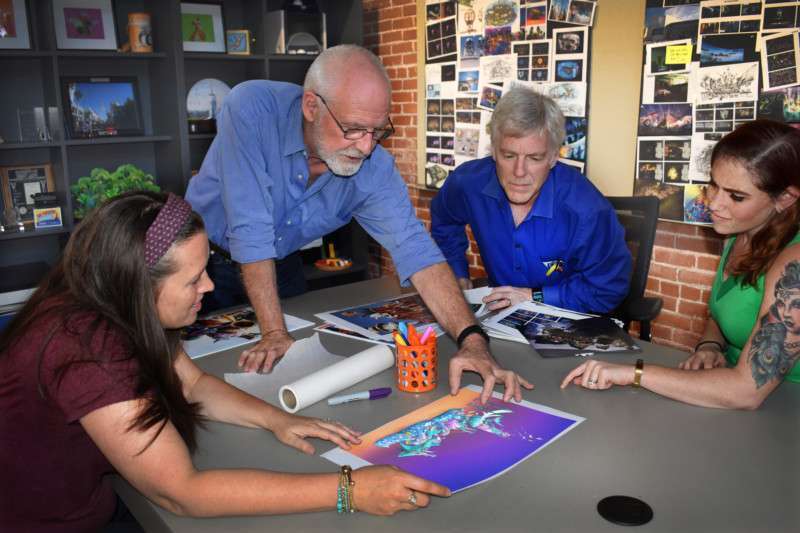THE HETTEMA GROUP TURNS 15
by Judith Rubin
The Hettema Group (THG) was founded in 2002 by Phil Hettema and is celebrating 15 years in business. This is an exciting landmark for the design and production firm, which has stood the test of time in a “roller coaster” industry that has had numerous booms and busts during those 15 years.
ABOVE PHOTO: Pictured L to R: The Hettema Group team members Gwen Ballantyne, Scott Sinclair, Anthony Pruett, Laura Garrett.
The driver of this company’s work is “aiming for awe” – creating projects that give guests goosebumps; borne out by some of their best-known work, such as One World Observatory, High Roller and “Beyond All Boundaries,” each of which has become an icon in its own way.
A hallmark of THG is a holistic approach to the company structure and culture, that supports a holistic approach to its projects. THG has architecture, technology, media and creative design teams all in-house. “This enables us to integrate the attraction into the setting to create a total/complete experience that you can’t get at home,” said Phil Hettema.
The company founder and leader is a themed entertainment industry legend with decades of experience, and among the staff are many Hettema peers of comparable status and background. But nobody rests on their laurels. In this company culture, they make a point of mixing things up to stay current and fresh and inclusive, because creativity and collaboration are key. The age span of the THG team, from recent grads to seasoned industry professionals, reflects a company that values experience as well as new perspectives – what they call “wisdom meets wonder.”
One of the phrases Phil likes to use about the special mix of creativity THG brings to its guest experiences is “secret sauce.” We set out to try and define some of the ingredients of that “secret sauce” of this company based in Pasadena, CA and creating iconic attractions all over the world.
In 15 years, THG projects have taken THG teams to such diverse destinations as Korea, China, Malaysia, and Jordan and from coast to coast in the US. Along the way, Phil and his team have had their own magical, once-in-a-lifetime experiences while creating compelling educational and entertaining experiences for audiences around the globe. Among these, Phil mentions “standing on the observatory level of One World Trade Center before the windows were on, flying in a B-17, and petting a penguin.”
Ask a client, colleague or collaborator about Phil Hettema and The Hettema Group, and some of the recurring themes are:
• Ability to quickly grasp the concept and communicate the vision
• Holding true to the vision from the beginning to the end
• Understanding what’s possible, even if it hasn’t been done before, and challenging the team to accomplish it
• A great communicator and collaborator
• Someone who listens carefully to the client and then knocks their socks off
• Surrounded by a great team
• A creative genius
• Honesty and integrity
• A friend
Vision, creativity and collaboration: Hettema colleagues, clients and projects
The Hettema Group’s projects frequently achieve iconic status, and they inspire long-standing relationships with colleagues and clients. Collaboration and vision are some of the words that come up in the course of conversation about Phil and his team – and “Phil’s team” is a key phrase. It seems that the collaborative nature of the Hettema process is key to the often iconic result.
THG got its start when Jeffrey Katzenberg, a longtime collaborator and client, recommended Phil for a project in Jordan. Katzenberg, whose current company is WndrCo, said, “I’ve known Phil for more than 30 years, having worked with him collaborating all the way back to the days at Disney. I worked with him during his time at Universal when DreamWorks had a theme park deal with Universal, and then with him directly at DreamWorks Animation.
“Phil is one of the most innovative and creative and dynamic storytellers in the world of live experiences,” said Katzenberg. “He’s done so many amazing projects over the years – everything from Seuss Landing at Universal, to One World Observatory in New York. He’s just incredibly diverse and skilled at all the many elements of threedimensional storytelling. He is pretty unique.”
Game changer for Las Vegas: The High Roller
Creating the High Roller observation wheel in Las Vegas for Caesars Entertainment Inc. brought together three veterans of Universal Studios – David Codiga, Greg Miller and Phil Hettema – to augment the Vegas skyline and bring a new kind of guest experience to the city. At the heart of this successful and distinctive project, which opened in 2014, is the re-imagining of the observation wheel. The High Roller has been likened to a charm bracelet, with its elegant, single-tube design, spherical glass cars and unique lighting scheme.
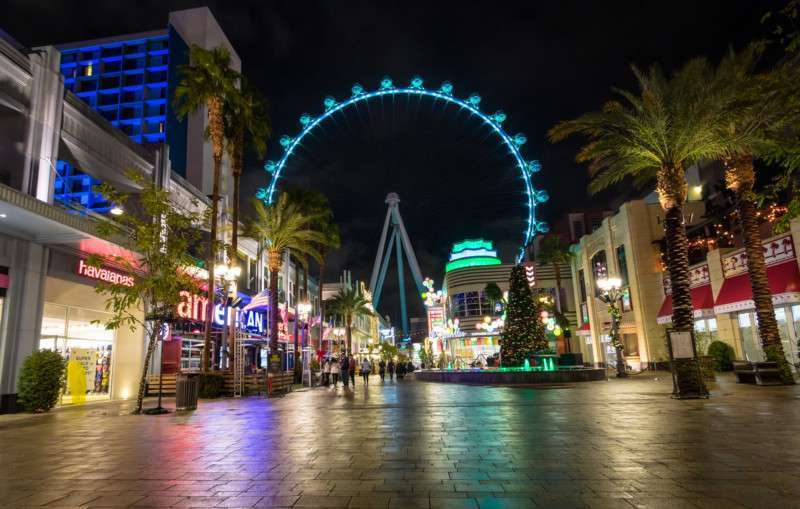
Codiga and Hettema met in 1987, the year they both started at Universal, respectively as project coordinator and producer/project manager. In 1998, when Codiga departed, he was president of Universal Creative; Phil, who remained until 2001, was senior VP of attraction development. They next worked together when Codiga became owner’s rep for The LINQ and Caesars Entertainment, where Miller was executive VP. Miller had brought in THG to design and art-direct on the High Roller, and consult on The LINQ. Miller, an operations and development specialist, had joined Caesars after eight years as president of Universal Studios PortAventura in Spain and is currently chief development officer with Great Wolf Resorts.
The High Roller and LINQ were part of a major development initiative by Caesars Entertainment. Miller said, “It was clear to me Phil would be best equipped to do the work – innovative and thoughtful, able to understand the Las Vegas customer and develop something compelling for them. His approach is not formulaic. He really thinks through creative challenges and is able to clearly communicate his vision of the product.”
“Phil knows how to hold the vision through to the end,” said Codiga. “He sees not only design aspects but guest experience and entertainment value. He instantly recognized that the High Roller had to be beautiful, streamlined, and aesthetically pleasing – not just a 30-minute ride over the skyline, but different from anything else you can do in Las Vegas. The challenge
became how to create a completely spherical cabin; how to make the wheel itself a single tube. He pushed Arup (the engineering firm on the project) to see it.”
Today, reported Miller, the High Roller – which, at 550 feet high, earned a place in the Guinness Book of World Records for tallest observation wheel – is doing what it was intended to do in terms of earning a profit, high guest satisfaction and repeatability, and iconic status.
“It was game changing for Vegas,” said Miller.
Game changer for New Orleans: Beyond All Boundaries
“One of the things I didn’t anticipate when I transitioned from the university to the museum world was the pleasure of working with creatives like Phil Hettema,” said Nick Mueller, co-founder (with the late Stephen Ambrose) of The National World War II Museum, which opened in 2000 in New Orleans.
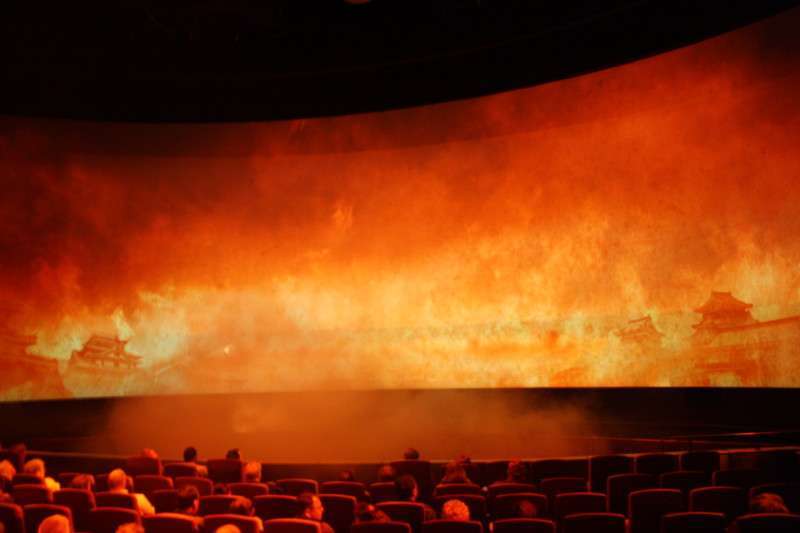
THG was still a young company when Patrick Gallagher [of Gallagher and Associates, designer of the museum] introduced Mueller to Hettema in 2002. “But I knew Phil’s reputation and work, and I wasn’t afraid of taking an experiential approach,” said Mueller. In the planning charrette for what would become the 4D multimedia experience, “Beyond All Boundaries,” which THG would collaborate with the museum to develop, design and produce, Mueller shared his idea of “a theatrical cinematic experience that would be beyond all boundaries… my own sense was that nobody had done a cinematic experience that was epic in quality to match the story we were telling – though I had no clue how to do what I had in my mind. It had to be authentic and true to story. You cannot do World War II in 20 minutes. Phil said, ‘It will be whatever it has to be.’”
As Mueller reported, “Phil could explain to a layman who doesn’t understand the technology how he could do it. And he had a personal stake: his dad was a World War II veteran. ‘I can’t get this wrong.’ He had a deep affection for his father’s story.”
Tom Hanks joined as executive producer. Hettema put together a creative team to deliver a project that integrated media, set pieces, lighting, sound and effects. “Beyond All Boundaries” stands today as one of the great examples of how themed entertainment tools and process can deliver a compelling, authentic educational experience.
“Phil is one of the most creative minds that I’ve encountered in the museum world or the attraction world; he immediately gets the core of the story,” said Mueller. “He is a wonderful storyteller and knows how to use technology to enhance the story in a powerful way. He listens to the client very carefully, and amazes you with what he comes back with. He’s a genius, an amazingly gifted individual.”
There was a lot riding on the success of “Beyond All Boundaries” when it opened in 2009, four years after Hurricane Katrina had devastated the city. “We were taking a big risk on one signature attraction, and it had to be equal to some of the things I’d seen at Universal and Disney World,” said Mueller.
Today, the show continues to run in its 240-seat, custom theater, seven days a week, 6-7 times a day to rave reviews. “Beyond All Boundaries” has been seen by some 4 million people to date and is a success on all fronts. “People come to New Orleans just to see it,” said Mueller. The show has been honored by TEA with a Thea Award for Outstanding Achievement, and by AAM with a Gold MUSE Award.
The Hettema Group has been re-engaged to create a central experience for the museum’s new Liberation Pavilion, a permanent exhibit space addressing the legacy and consequences of the war, targeted to open in 20192020.
An icon for New York City: One World Observatory
“One World Observatory is the kind of project we love to do,” said Phil – “one in which the audience brings an emotional connection or expectation, and we either satisfy that and/or take them to a new place. It’s the kind of project that makes me look around, pinch myself to make sure I’m not dreaming, and be deeply grateful and amazed.”
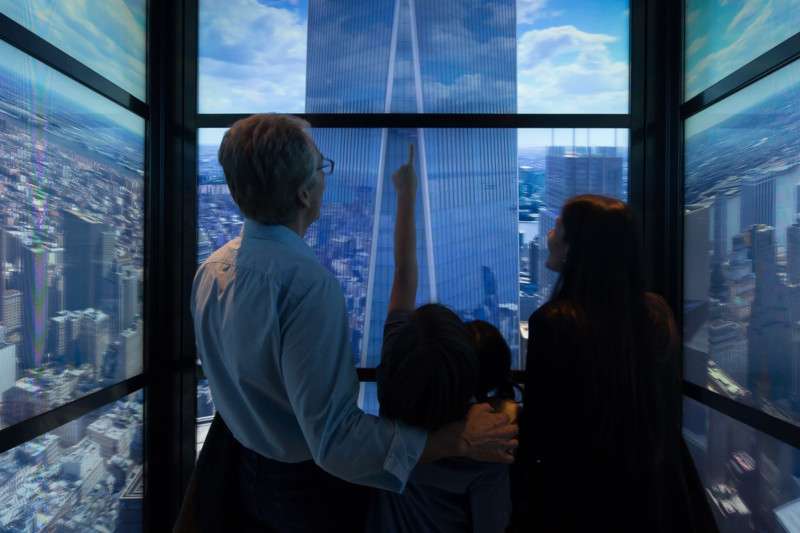
There were special challenges with story, concept and positioning in a project so connected to the destruction f the World Trade Center. “Here’s this world event of incalculable importance and gravity,” said Hettema. “Everyone who walks into this place is going to have 9/11 firmly in their minds. But from the beginning, the brief was that this was not a project about 9/11 per se. The 9/11 Memorial Museum is next door. The One World Observatory experience was to be about looking forward, about the notion of rising up again and thriving in the face of what had happened. We had to find a way to deal with that subtext without overtly stating it.
“We created a story around what was basically a view experience – an elevator ride and a great view,” said Phil. “I like to think that we were pretty successful, and that One World Observatory is a pioneering project.
“The key phrase is See Forever – to give a notion of what the future is or can be about – a context for thinking one’s own thoughts. We worked hard to put the World Trade Center into a longer context, from the elevator to the ‘reveal’ moment at the top. All those things combine to form the guest experience, and it’s been great to see visitors – New Yorkers and tourists alike – connect with it on a profound level and respond to the emotional message.”
One World Observatory opened at One World Trade Center on May 29, 2015. It has been honored with a TEA Thea Award for Outstanding Achievement.
Behind the walls of THG: The company consortium culture
One of the secrets of the “secret sauce” is that it is not secret. Hettema is a great team leader, and that means collaboration, and sharing the wisdom and the knowledge.
Many members of Phil’s team have decades of experience in theme parks and ties to theater as he does. Each brings individual expertise and vision. But they also all carry the flag of the project culture he has created.
The power of the team is part of the secret sauce. This is validated in how colleagues and clients speak about their project experiences, in how Phil’s team members talk about him and the company, and in how the company has grown over 15 years and achieved so many iconic projects considered game changers of the industry.
THG is steered by Hettema with Debbie Saale (general manager) and Anthony Pruett (senior vice president) and its staff includes some very distinguished names indeed, some who might be considered legendary figures of themed entertainment. The company makes a point of bringing in younger talent as well and cultivating an atmosphere of mutual respect where perspectives and experience are shared across disciplines as well as age groups.
The company staffs up and down as required by its projects, maintaining a core of about 50 people. Last year, the count was up to as many as 115 people. Over the years, the THG footprint has expanded within Pasadena, from the original office at 67 Valley into adjoining and nearby buildings.
As key components of the “secret sauce” are being multidisciplinary and collaborative, having the various disciplines represented under one roof facilitates communication, understanding and speedy results.
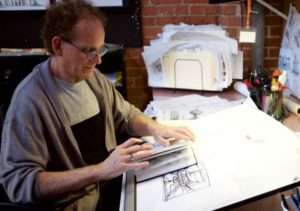
Said Joe Lanzisero (senior creative director), “These days, as media and architecture and experience all blur, it’s hard to draw lines. You can’t think of them separately as box
and experience. We’ve got to be an integrated team from the word ‘go’ – we can’t figure stuff out ‘later.’ I’ve been in this industry a long time, and honestly I have never worked with a more collaborative group.”
Lanzisero explained how THG’s in-house facility design group, headed up by Jodi Roberdes (director of facility design services) and Sunnie Burke (executive architect) allows the creative group to immediately sit with the people who can make a ‘crazy idea’ a reality. Roberdes said, “The multidisciplinary approach feeds the workflow throughout the team. We truly collaborate across those disciplines throughout a project. It’s a seamless, realtime process. I have been here going on nine years and in my mind, what this approach does for THG, besides understanding codes and facility, is to support the creative department however we can.”
“Phil has built something bigger than himself,” said Lanzisero. “He has infused this place with philosophies of design, empowerment of people, allowing them to be the best they can be, providing the most focused critique and insights into what you’re doing, based on years of building things and working with people. Deep in his heart, Phil is a showman first, understanding how to entertain people and put that sense of entertainment in whatever we do, engaging guests into the experience.”
Scott Sinclair (senior creative director) said, “It starts with management – with Anthony and Debbie and Phil, and trickles on down. We all embrace it because it works so well. We all feel like we matter because we do, all the way across the board. It’s a pretty fundamental part of our culture. Phil is just a good guy: It’s that simple. He has a reputation for being a good guy who does the right thing. We see it on a day-to-day basis and we all try to emulate that. It’s a win-win for everybody.” •
Phil Hettema career chronology and select projects
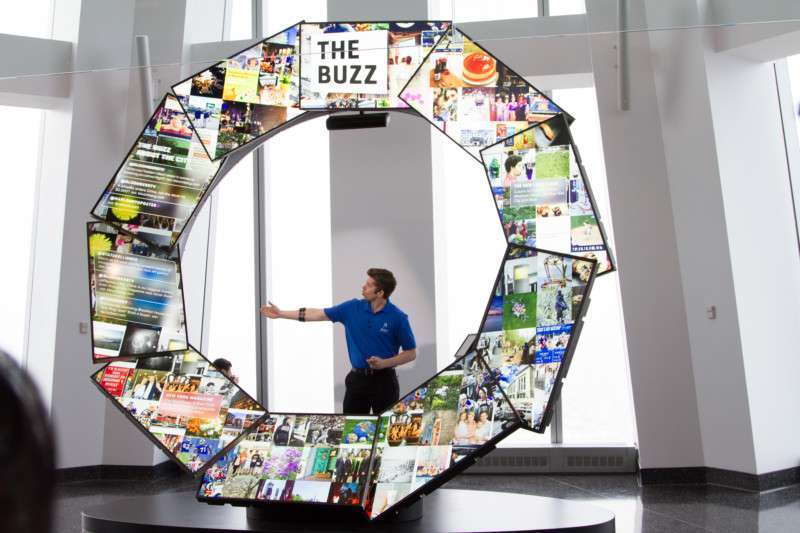
• Disneyland/Disney World Costume Department
• Sid & Marty Krofft (running the puppet shop)
• Designer and PM for Bob Jani (on many big events and shows)
• 1984 Los Angeles Olympic Games (opening and closing ceremonies, production supervisor)
• 1986 Statue of Liberty Centennial “Liberty Weekend” (production supervisor)
• Universal Creative – (SVP attraction development): Miami Vice, Back to the Future – The Ride, Jurassic Park, Universal Studios Japan, Universal Islands of Adventure
• THG – Saraya Aqaba, Beyond All Boundaries, High Roller, One World Observatory, USA Pavilion at Yeosu 2012 Expo, Dragons Wild Shooting (Lotte World), Hello Kitty Park (Anji, China)
In Phil’s own words
Storytelling and technology
“To be good at what we do, we have to become the simplest storytellers we can; it can be powerful but must be told simply and directly. A new technology or toy is nothing more than another brush in the paintbox. If you are designing an experience based on the technology alone it is almost guaranteed to be obsolete by the time it is built, and in five years, totally lame.
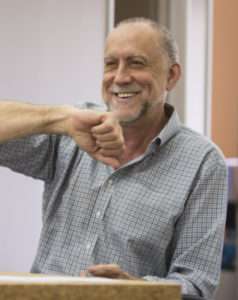
“The real question to ask is, ‘How do we create this experience in a way that really connects?’ In this age of media noise, people are so hungry to have experiences that reach in a little bit deeper. That shared experience will always be the secret sauce of what we do. The power of group activity comes from how we relate to each other while we’re doing it.”
The global industry
“The international aspect of our business is really fascinating, and far from simple. There’s a whole cultural exchange component to it. In our careers, we are fortunate to have traveled so much and to have lived in other countries. Working on an entertainment project overseas is a very meaningful and compelling exchange, very challenging from a business viewpoint and even a process viewpoint.
“While humor and drama and tradition and other cultural factors vary from country to country, there is still a common element: that very deep longing to connect to one another. Sometimes you have to take someone out of where they are at – and that might even include traditions too – to break through, and enable people to discover something new – and to discover one another in new ways. We all want to be seen by the people around us and to connect with them. It’s almost as fundamental as eating.”
RELATED STORY:
Phil Hettema: The basics of storytelling remain the same (as technology evolves)


